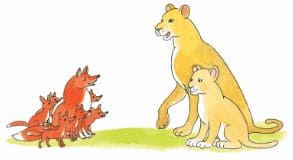Ответы к странице 131, Step 10
Задание 1. Read Aesop’s fable “The Lioness and The Fox” and choose the best moral is for it.

1) Agree with those who are stronger than you.
2) All others love their children.
3) Sometimes one thing can be better than a lot of things.
Once upon a time a lioness and a fox were talking about their young, as mothers always do. The lioness and the fox were happy that their children were healthy and active. The mothers thought their children were very beautiful and clever and were proud of them.
The fox said, “My little cubs are very nice. Look how they are running in the garden grass. I think they are the most wonderful fox cubs in the world. You can’t find better cubs!” Then the fox looked at the lion cub and added: “I have got six cubs this year, I had seven cubs last year, but you as I see, never have more than one.”
“No, I don’t,” said the lioness and looked proudly at her cub, “but that one is a lion.”
Прочитай басню Эзопа «Львица и Лиса» и выбери наиболее подходящую мораль для нее.
1) Всегда соглашайся с тем, кто сильнее тебя.
2) Все матери любят своих детей.
3) Иногда одна вещь может быть лучше, чем много других.
Давным−давно львица и лиса разговаривали о своих малышах, как обычно делают матери. Львица и лиса были счастливы, потому что их дети были здоровы и активны. Матери думали, их дети были красивы и умны, и очень ими гордились.
Лиса сказала «Мои маленькие детеныши очень милые. Смотри, как они бегают по зеленой траве. Я думаю, они самые прекрасные лисята в мире. Ты не сможешь найти лучше!» Потом лиса посмотрела на львенка и добавила: «У меня в этом году 6 детенышей, в прошлом году у меня было 7, но у тебя, как я вижу, никогда больше одного.»
«Да, никогда,» сказала львица и с гордостью посмотрела на своего детеныша, «но этот один – лев.»
Ответ:
The best moral is 3) Sometimes one thing can be better than a lot of things.
Перевод:
Лучшая мораль − 3) Иногда одна вещь может быть лучше, чем много других.
Задание 2. Say who did it (was doing it) in the fable.
1) Who was talking to the fox?
2) Who was healthy and active?
3) Who was happy because of that?
4) Who was proud of the cubs?
5) Who was running and playing in the grass?
6) Who had six cubs?
7) Who had one cub?
Скажи, кто это делал в басне.
1) Кто разговаривал с лисой?
2) Кто был здоровый и активный?
3) Кто был счастлив от этого?
4) Кто гордился детенышами?
5) Кто бегал и играл в траве?
6) У кого было 6 детенышей?
7) У кого был 1 детеныш?
Ответ:
1) The lioness did.
2) The cubs were.
3) The mothers were.
4) The mothers were.
5) The fox cubs were.
6) The fox had.
7) The lioness had.
Перевод:
1) Львица.
2) Детеныши.
3) Матери.
4) Матери.
5) Лисята.
6) У лисицы.
7) У львицы.
Задание 3. Answer the questions.
1) The lioness and the she−fox were happy about their cubs, weren’t they?
2) Mothers often speak about their children, don’t they?
3) The lioness was not proud of her cubs, was she?
4) The cubs were not clever and beautiful, were they?
5) Where were the fox cubs running and playing?
6) How many cubs did the fox have?
7) How many cubs did the lioness have?
8) The lioness was not sad because she had one cub, was she?
9) Why, do you think, she was not sad?
Ответь на вопросы.
1) Львица и лисица были рады своим детенышам, не так ли?
2) Матери часто говорят о своих детях, не так ли?
3) Львица не гордилась своими детенышами, так?
4) Детеныши не были умными и красивыми, так?
5) Где бегали и играли лисята?
6) Сколько детенышей было у лисы?
7) Сколько детенышей было у львицы?
8) Львица не была грустной, потому что у нее был один детеныш, не так ли?
9) Почему, ты думаешь, ей не было грустно?
Ответ:
1) Yes, they were.
2) Yes, they do.
3) Yes, she was.
4) Yes, they were.
5) In the green grass.
6) Six cubs.
7) One cub.
8) No, she wasn’t.
9) Because her cub was a lion.
Перевод:
1) Да, они были.
2) Да.
3) Да, она была.
4) Да, они были.
5) В зеленой траве.
6) Шесть детенышей.
7) Один.
8) Нет, она не была.
9) Потому что ее детеныш был львом.

